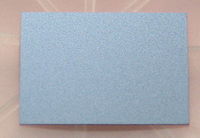Indium Phosphide
 |
|
 |
|
| Names | |
|---|---|
| Other names
Indium(III) phosphide
|
|
| Identifiers | |
|
3D model (Jmol)
|
|
| ChemSpider | |
| ECHA InfoCard | 100.040.856 |
|
PubChem CID
|
|
|
|
|
|
| Properties | |
| InP | |
| Molar mass | 145.792 g/mol |
| Appearance | black cubic crystals |
| Density | 4.81 g/cm3, solid |
| Melting point | 1,062 °C (1,944 °F; 1,335 K) |
| Solubility | slightly soluble in acids |
| Band gap | 1.344 eV (300 K; direct) |
| Electron mobility | 5400 cm2/(V·s) (300 K) |
| Thermal conductivity | 0.68 W/(cm·K) (300 K) |
|
Refractive index (nD)
|
3.1 (infrared); 3.55 (632.8 nm) |
| Structure | |
| Zinc blende | |
|
a = 5.8687 Å
|
|
| Tetrahedral | |
| Thermochemistry | |
| 45.4 J/(mol·K) | |
|
Std molar
entropy (S |
59.8 J/(mol·K) |
|
Std enthalpy of
formation (ΔfH |
-88.7 kJ/mol |
| Hazards | |
| Main hazards | Toxic, hydrolysis to phosphine |
| Safety data sheet | External MSDS |
| Related compounds | |
|
Other anions
|
Indium nitride Indium arsenide Indium antimonide |
|
Other cations
|
Aluminium phosphide Gallium phosphide |
|
Related compounds
|
Indium gallium phosphide Aluminium gallium indium phosphide Gallium indium arsenide antimonide phosphide |
|
Except where otherwise noted, data are given for materials in their standard state (at 25 °C [77 °F], 100 kPa).
|
|
|
|
|
| Infobox references | |
Indium phosphide (InP) is a binary semiconductor composed of indium and phosphorus. It has a face-centered cubic ("zincblende") crystal structure, identical to that of GaAs and most of the III-V semiconductors.
Indium phosphide can be prepared from the reaction of white phosphorus and indium iodide at 400 °C., also by direct combination of the purified elements at high temperature and pressure, or by thermal decomposition of a mixture of a trialkyl indium compound and phosphine.
InP is used in high-power and high-frequency electronics because of its superior electron velocity with respect to the more common semiconductors silicon and gallium arsenide.
It was used with indium gallium arsenide to make a record breaking pseudomorphic heterojunction bipolar transistor that could operate at 604 GHz.
It also has a direct bandgap, making it useful for optoelectronics devices like laser diodes.
InP is also used as a substrate for epitaxial indium gallium arsenide based opto-electronic devices.
Indium phosphide also has one of the longest-lived optical phonons of any compound with the zincblende crystal structure.
...
Wikipedia
